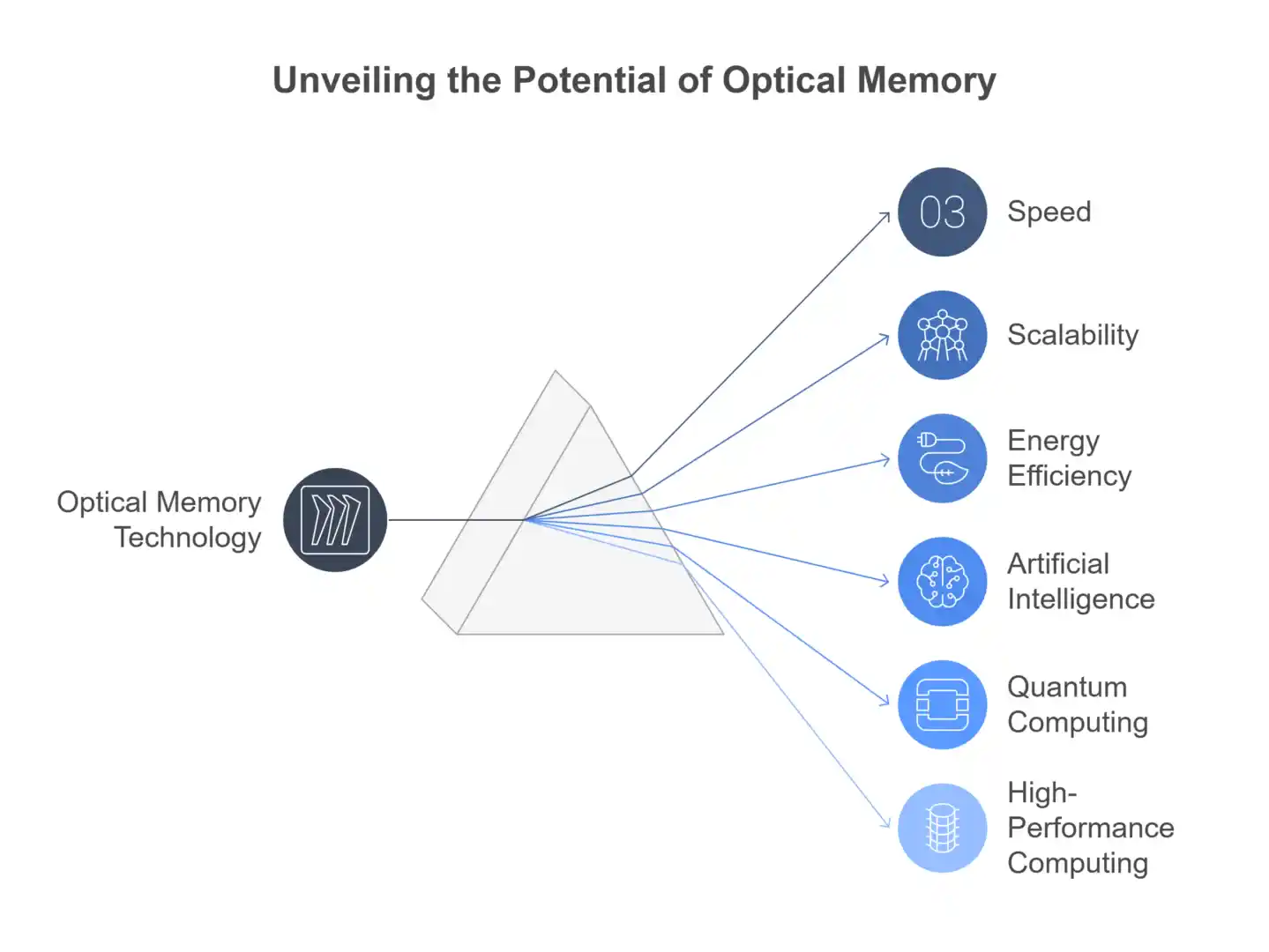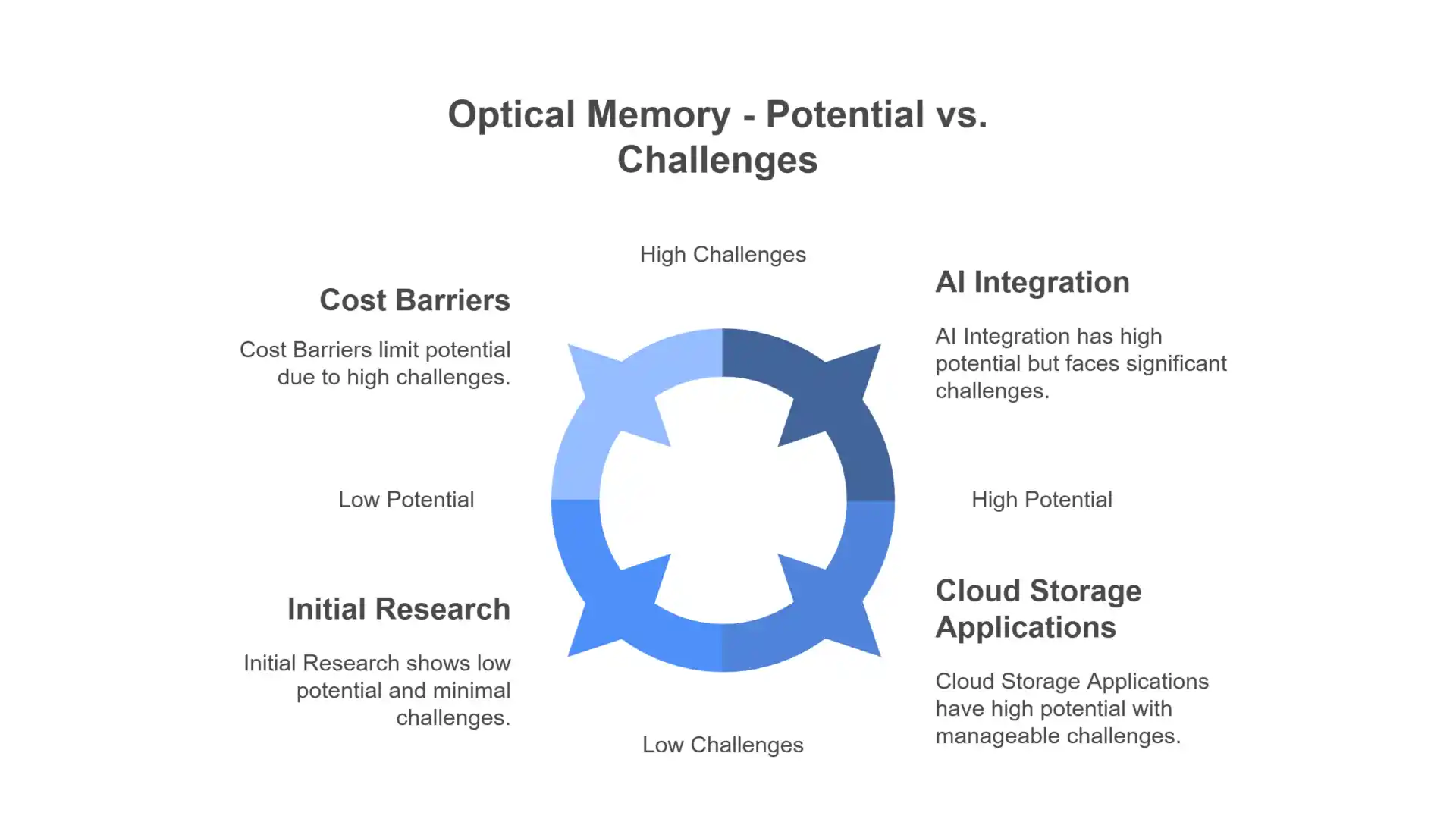Table of Contents
Optical memory is basically data storage and retrieval technology. It uses the light, preferably lasers, in reading and writing data. Compared to the more traditional electronic memory, which operates on electrical charges, optical memory uses photonic properties for higher speed and efficiency in data processing.
Importance of Memory Scalability in Modern Computing
Computing demands are increased, and the regular memory solutions cannot support this demand with enough scalability, energy consumption, and processing speed. Artificial intelligence is flooding the world these days, along with big data analytics, and quantum computing-the need for scalable and high-speed memory solutions. Optical memory brings a new opportunity in the form of higher data storage density and lower energy consumption.

Overview of How Optical Memory Enhances Processing Speed and Efficiency
It allows near-instantaneous read/write operations and greatly eliminates bottlenecks in data transfers. It bypasses the electric resistance and heating problems associated with traditional semiconductor-based memory, ensuring greater efficiency and longer-lasting storage solutions.
Basic Principles of Optical Data Storage
Optical memory is read or written by using a laser beam to detect light. It is very common in storage devices such as CDs, DVDs, Blu-ray discs, and optical hard drives. In detail, how it works is as follows:
Data Encoding: Encoding data into tiny pits and lands, the information is encoded on an optical disc. These pits, actually an indentation or a mark on the disc’s surface, are lands, which are flat areas between pits. They follow a spiral track that covers the entire disc surface.
Laser Read/Write Mechanism:
- Reading: When the disc is inserted into a player, a laser beam is shot onto the surface of the disc. The pattern changes because it reflects off the surface when it hits a pit or a land, changing the pattern reflected based on whether it strikes a pit or a land. The sensor picks these changes and translates them into digital information (binary 1s and 0s).
- Writing: A laser is used on writable optical disks to change the surface of that disk. Laser light heats particular areas to which it is shone, bringing the material up to a high enough temperature where it will transform its state—say, switching from a crystal state to a more amorphous state with rewritable CDs and DVDs (DVDs-RW).
Storage Capacity: The capacity of storage that a disc will have is defined by the pit and land density. The pits are smaller the closer they are to each other, meaning there can be a larger amount of data stored. Blu-ray, for instance, uses a laser with a much shorter wavelength compared to DVDs and CDs, making it possible to fit more data into the same space.
Error Correction: Optical memory systems generally carry error correction codes that enable the detection and correction of small errors in the data due to scratches, dust, or imperfections on the disc surface.
Comparison with Traditional Electronic Memory (RAM, SSDs)
- RAM & SSDs: Use electronic signals for data access, which dissipates power and generates heat.
- Optical Memory: It uses photons for data transmission, which enables faster speeds, less heat output, and more durability.
Types of Optical Memory Technologies
- Holographic Memory: Data is stored in three-dimensional holograms inside a crystal or photopolymer.
- Photonic Memory: Using light pulses for storing and retrieval, this kind of memory promises ultra-fast processing speeds.
- Optical Disc-Based Memory: This includes Blu-ray and other advanced optical storage formats that make use of laser technology.
Key Advantages of Optical Memory
- Faster Read/Write Speeds: It uses high-speed laser pulses that reduce latency while using optical memory compared to electronic memory solutions.
- High Scalability and Data Density: Optical storage media can store a huge amount of data in a compact form, which promises to be the right solution for scalable computing requirements.
- Energy Efficiency and Reduced Heat Generation: On the other hand, optical memory does not lose much energy through electrical resistance, thus minimizing the total power consumption and the amount of generated heat.
- Durability and Long-Term Data Retention: The optical memory materials resist degradation due to the environment. This ensures longer data retention periods and infrequent replacements.
Challenges and Limitations
- Current Technological Hurdles: Despite the promise it holds, optical memory has a challenge associated with stability, rate in encoding data, and material development.
- Cost Factors in Implementation: Developing and manufacturing optical memory solutions are expensive.
- Compatibility with Existing Computing Architectures: Most existing computing systems are built to use electronic memory, making integration with optical memory technologies challenging and requiring new infrastructure investments.

Applications of Optical Memory
- AI and Machine Learning Acceleration: AI and deep learning models have high memory bandwidth. Optical memory can provide access to data faster, improving training times and inference speeds.
- Quantum Computing Integration: Optical memory integrates well with quantum computing since the storage and processing of information is based on photonic properties in both.
- High-Performance Computing (HPC) and Big Data Analytics: HPC applications demand ultra-fast data retrieval. Optical memory improves computational efficiency by reducing memory bottlenecks.
- Cloud Storage and Data Centers: With increasing demands on sustainability and the capability to have massive cloud storage, optical memory has the ability to offer an alternative for sustainable power consumption to conventional hard drives and SSDs.
Future Trends and Research
- Advances in Materials and Photonics: Sophisticated research in photonic materials, including nanophotonics and meta-materials, will have to provide more efficient systems for optical memory.
- Emerging Breakthroughs in Optical Memory Scalability: Novel approaches for optical memory scaling include monolithically integrated photonic chip structures and hybrid optical-electronic memory. Both approaches are promoting increased scalability while increasing the practical viability of the storage.
- Industry Adoption and Potential Market Impact: Tech giants and startups are investing in optical memory research, which indicates a shift toward broader industry adoption in the near future.
Tech Leaders Adopting Optical Memory
Currently, various leading tech firms are focused on researching and investing in the fields of optical memory technologies so as to optimize their data storage and processing efficiency. Some examples are as follows:
- Microsoft and Hitachi: The two significant technological firms currently studying research under 5D optical data storage. Microsoft with Hitachi; using nano-structured glass this data is inscribed permanently using it. That potentially could range in the gigabyte storage and span billions of years for discs having 360 TB capacity.
- NTT (Nippon Telegraph and Telephone Corporation): NTT has developed an optical random access memory (o-RAM) chip that uses light instead of electrical signals for data storage. The innovation is intended to enhance the speed and efficiency of data transmission in networking equipment, such as routers and data center switches.
- Celestial AI: The firm, Celestial AI, developed the optical interconnect technology called Photonic Fabric to address the “memory wall challenge” of AI systems. By transmitting data between memory chips and processors with light, the company hopes that data transfer becomes much faster while reducing latency for the performance improvement of AI models. The company has raised funding worth $100 million from firms such as Samsung Electronics and Porsche AG.
- Ayar Labs: Ayar Labs is a startup that specializes in optical communication solutions. The firm develops chiplets that transmit data through light pulses. The new technology seeks to solve current issues with the current data transmission approach in AI-driven data centers. The company recently received $155 million from giant tech companies including AMD, Intel, and Nvidia.
Such programs reflect an emerging interest from large tech firms to develop optical memory technologies. It is primarily targeted at catering to the burgeoning need for high-speed, energy-efficient data storage and processing technologies.
Conclusion
Optical memory is revolutionizing the future of data storage: it boasts significantly higher speeds and scalability while saving energy relative to electronic memory. It can significantly be leveraged in the domains of AI, quantum computing, HPC, and cloud storage.
As research continues to hone optical memory technology, it is sure to be a part of mainstream computing. Its potential will only be fully unlocked by overcoming cost and compatibility barriers.
READ MORE:
Top 30 AI Companies in India to Know About in 2025
Linux File Permissions: 3 Essential Commands for Ultimate System Security